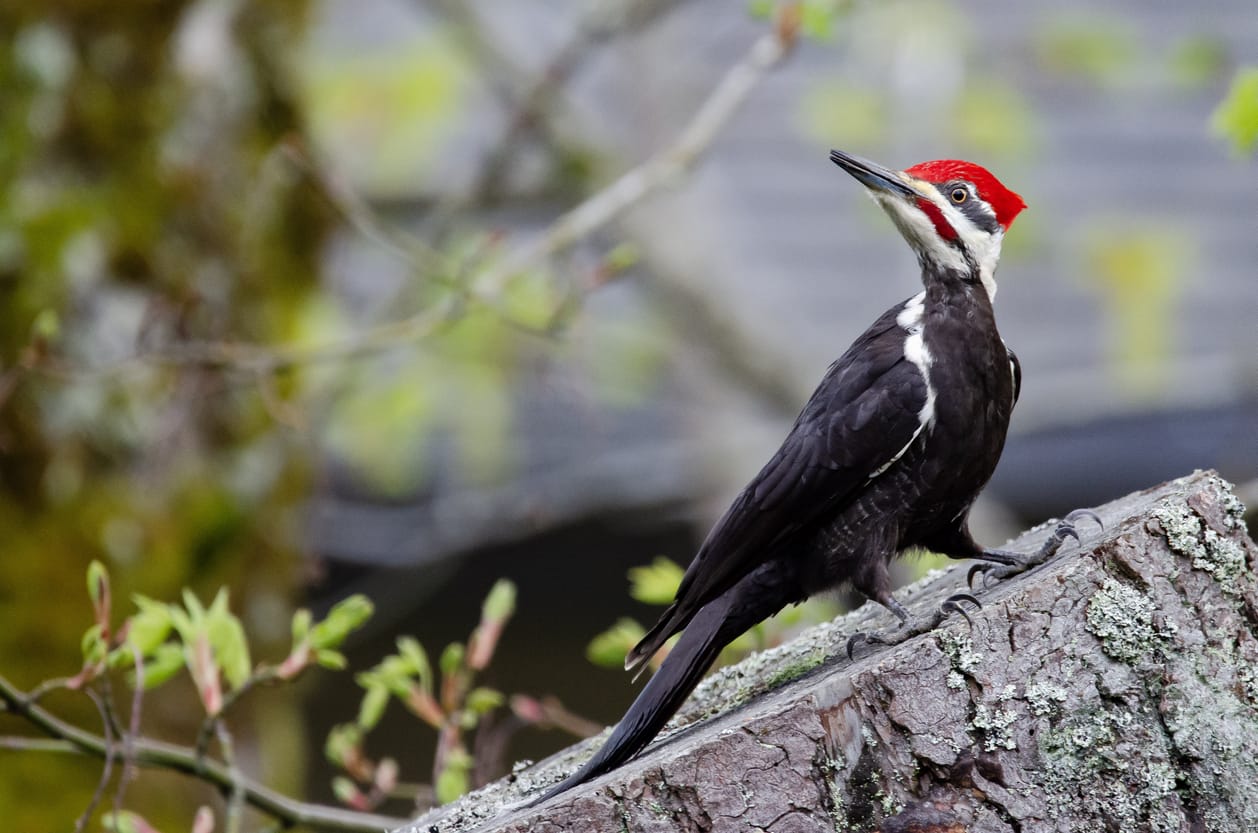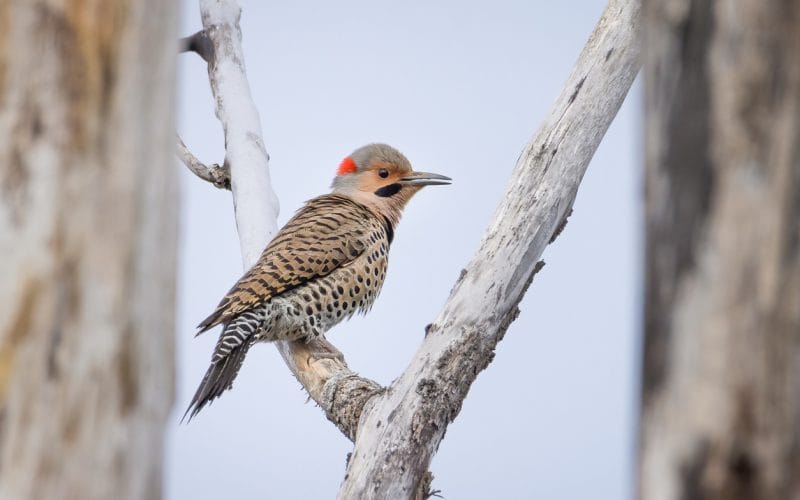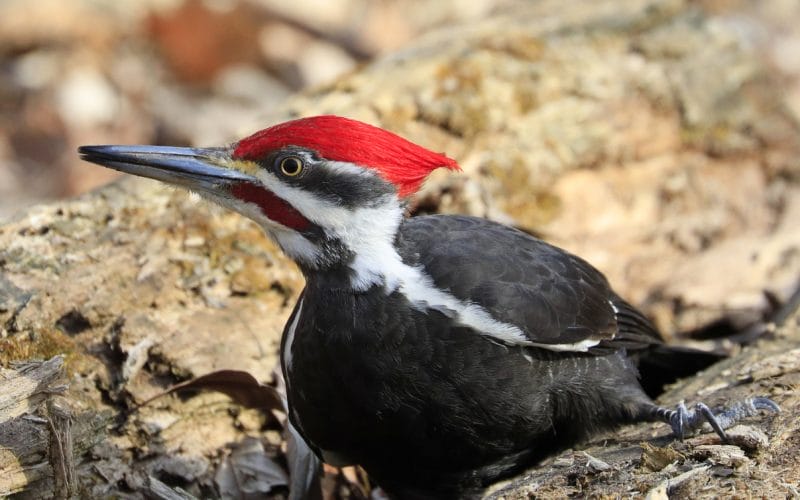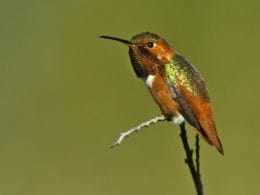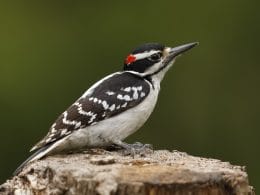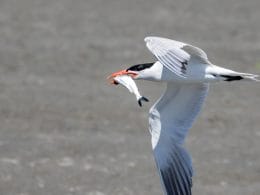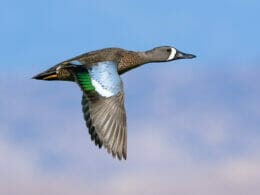There are many species of woodpeckers in the United States. They’re known for their colorful plumage and playful attitude.
As the fifth greenest state, Maryland has the habitat required to host a number of woodpecker species. In fact, there are eight species of woodpeckers in Maryland.
Read on for all you need to know about the species of woodpeckers in Maryland, their habitats, diets, and more
Different Species of Woodpeckers in Maryland
There are eight different species of woodpeckers in the state of Maryland. These species live and breed within the forested areas and wetlands in the state. The woodpecker species of Maryland are:
1. The Red-Cockaded Woodpecker
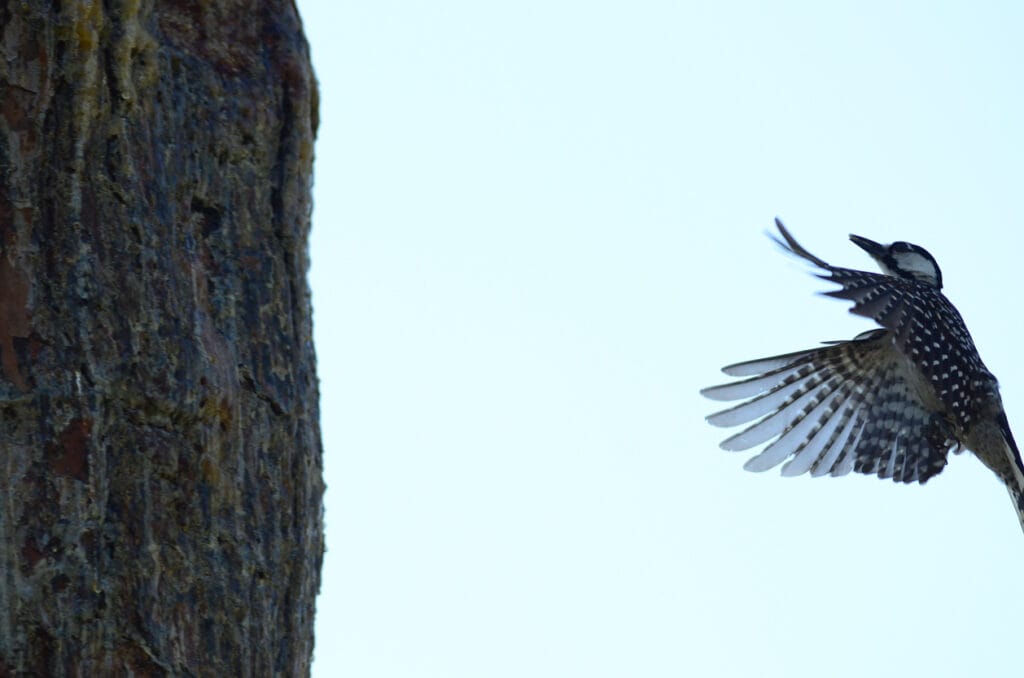
- Scientific Name: Dryobates Borealis
- Length: 1 to 9.1 in
- Weight: 4 to 2.0 oz
- Wingspan: 13 to 16 in
This woodpecker got its name from the red cockade, which is a red streak rarely ever seen on its cap.
Author Note: The Red-Cockaded Woodpecker has a black and white pattern on its plumage. It also features a black head and nape and white patches on the cheeks.
This species loves pines. Their favorite habitat is the large pine trees. They live in the cavities they drill in those pine trees. Moreover, pine fruit forms an important portion of their diet alongside insects such as caterpillars, cockroaches, and spiders.
The job of the Red-Cockaded Woodpecker is usually made easier thanks to the Red Heart Fungus. This fungus makes cavity excavation a lot easier for this species of woodpeckers by infecting the pine trees and softening their barks.
2. The Yellow-Bellied Sapsucker

- Scientific Name: Sphyrapicus varius
- Length: 7.1-8.7 in
- Weight: 1.5-1.9 oz
- Wingspan: 13.4-15.8 in
Despite their name, the Yellow-Bellied Woodpeckers are mostly black and white with some pale yellow markings on the undersides. They feature white stripes down their necks and red flashy foreheads. Moreover, the males of this species feature red throats.
These birds are as small as a robin. They’re known for their relatively long wings and short bills. You can spot these migratory birds in Maryland during migration and in winter.
These woodpeckers form horizontal rows of cavities in trees. They use their tongues with the brush-like tip to get sap. They have to frequently maintain their cavities to keep sucking on the oozing sap and eat any insect attracted to it.
The Yellow-Bellied woodpeckers usually prefer certain trees such as yellow birch, hickory, sugar or red maple, and young paper birch. They typically lay five or six eggs and nest in the cavities of trees.
Birds of this species are known for their cat-like mewing calls and staccato drumming. They tend to get louder during spring and can be extremely noisy.
3. The Hairy Woodpecker
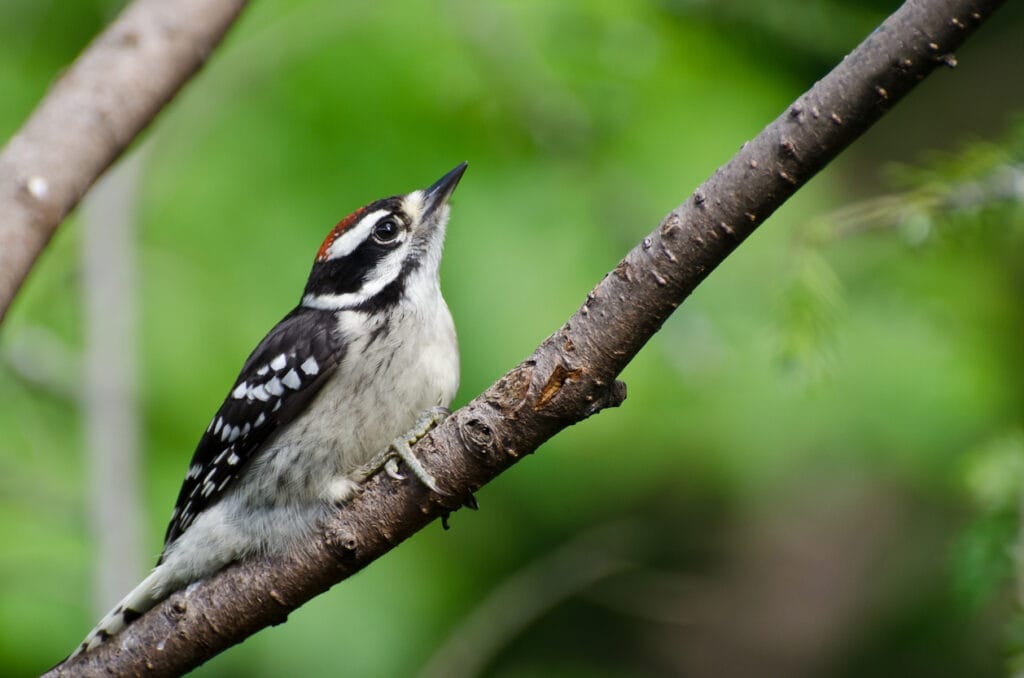
- Scientific Name: Leuconotopicus Villosus
- Length: 7.1-10.2 in
- Weight: 1.4-3.4 oz
- Wingspan: 13.0-16.1 in
The Hairy Woodpeckers are medium-sized birds. They’re known for their plumage that features a black and white pattern with a large white patch at the back. They have a large chisel-like bill. The adult males of this species feature a red streak at the back of their heads.
These woodpeckers can mainly be spotted in the fully matured forests of Maryland. They can also be found in swamps, urban parks, orchards, suburban backyards, and sometimes even cemeteries.
The Hairy Woodpecker is sometimes confused with the Downy woodpecker. Although it’s hard to differentiate between them, there are some signs to tell them apart. On the one hand, the Hairy Woodpecker is larger with a longer and sharper bill. On the other hand, you can recognize the Hairy Woodpecker through its explosive-like calls or powerful whinnying sound.
Author Note: Birds of this species mostly eat wood-born insects like bark beetle larvae and ants. Sometimes, they can also consume spiders, millipedes, pupae, bees, and caterpillars.
These birds can usually be found around tall trees searching for insects or sab that other species have left behind in holes. They lay from 3 to 6 eggs within the cavities of dead trees.
4. The Pileated Woodpecker

- Scientific Name: Dryocopus pileatus
- Length: 15.8-19.3 in
- Weight: 8.8-12.3 oz
- Wingspan: 26.0-29.5 in
The Pileated Woodpeckers can be easily identified. It’s the largest among woodpecker species in the state of Maryland and North America. They’re almost the size of a crow.
With their red crests, these birds are the first that comes to your mind when you think of woodpeckers. They’re the most famous among all species of woodpeckers.
They feature large bright red triangular crests on top of their heads and bold white stripes down the sides of their necks. There’s also an extra red streak on the cheek of the adult male.
You can identify this species of woodpeckers by its loud shrill whiny. It makes a loud drumming noise while pecking into trees with its long sharp bill.
These birds drill distinct rectangular holes and frequently excavate to look for food, especially carpenter ants but may also eat berries, wild fruits, and nuts.
The Pileated Woodpecker would choose a new spot within the cavities of dead trees to make its nest every single year. They normally lay between three and five white eggs.
The birds of this species can most commonly be found across the conifer forests of Maryland. However, they can also be seen around the edges of large cities.
Contrary to popular belief, this species prefers drilling into dead trees or softer wood logs rather than live ones.
5. The Northern Flicker

- Scientific Name:Colaptes auratus
- Length: 11.0-12.2 in
- Weight: 3.9-5.6 oz
- Wingspan: 16.5-20.1 in
These woodpeckers can be found year-round in Maryland. They mostly occupy woodlands, especially those with open fields and spaces.
Northern Flickers are the only woodpeckers with plumage different from the traditional black and white coloration of woodpeckers. They feature distinctive gray and brown plumage, which makes them stand out as the only species in the state of Maryland that features such colors.
The Northern Flickers are relatively big birds with large curved bills and round slim heads. They have darker streaks on their undersides and bright yellow streaks on their tails and wings. Some say that you can see a yellow flash of light while they fly. They also feature a red nape on their necks and a white patch on their rumps.
Top Tip: These woodpeckers make repetitive piercing calls and are known for their deep tree drumming, by which they communicate with one another. They’re also among the few species that can walk vertically on tree trunks thanks to their zygodactyl feet.
Unlike most other woodpecker species, you can spot the Northern Flickers near the ground, foraging for beetles and ants. They can also eat fruits. Northern Flickers tend to nest in the cavities they make in trees to lay between five and eight white eggs.
6. The Red-Bellied Woodpecker

- Scientific Name: Melanerpes carolinus
- Length: 9.4 in
- Weight: 2.0-3.2 oz
- Wingspan: 13.0-16.5 in
Red-Bellied Woodpeckers have black and white plumage like most other woodpecker species. They feature the usual markings on their backs. Despite their names, you can hardly notice any hint of red down their bellies. Their only sign of red appears on their heads. The adult Red-Bellied female has a red on the nape but none on the crown.
There’s another difference between males and females of this species. Males have tongues that are longer and wider than those of females. This usually comes in handy during breeding season because it allows them to forage for food in different areas to get the best variety of food for their chicks.
Red-Bellied Woodpeckers can be spotted in Maryland year-round. They are adaptable birds that can live in urban settings as well as forests. Therefore, it’s highly likely to see birds of this species around your backyard feeder.
This species of woodpeckers feed on insects, spiders, nuts, fruits, and seeds from grass. These birds stick to their very same nest for years. They lay four or five white eggs on a bed of wood chips.
You can recognize these birds through their various loud sounds, including trills and chuckles. They also make loud deep drumming on trees as a means of communication with one another.
7. The Downy Woodpecker
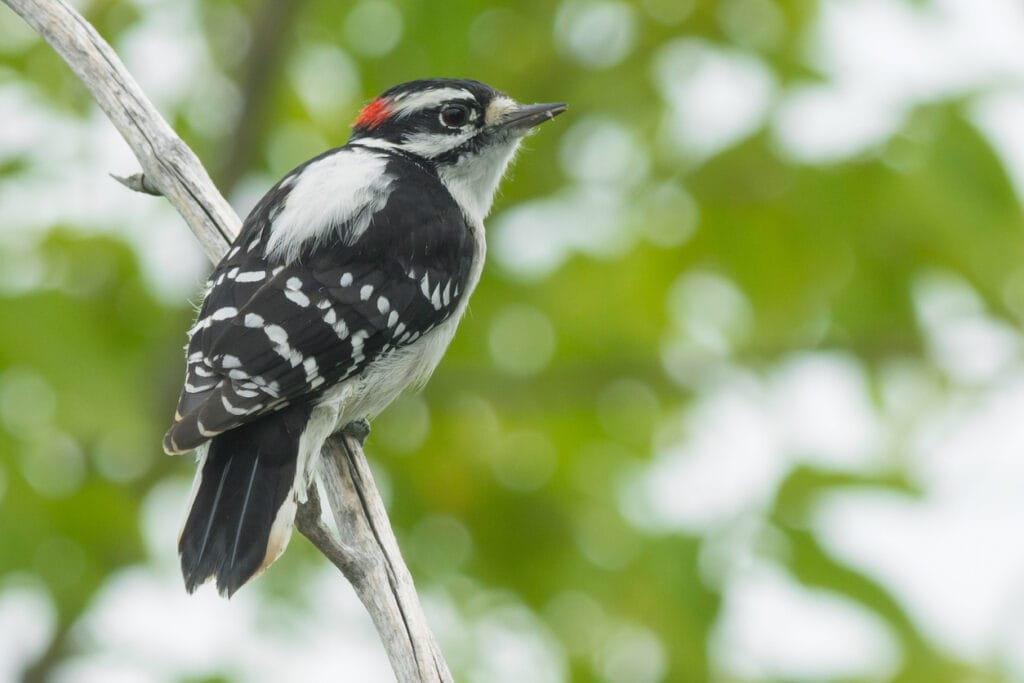
- Scientific Name: Picoides pubescens
- Length: 5.5-6.7 in
- Weight: 0.7-1.0 oz
- Wingspan: 9.8-11.8 in
The Downy Woodpecker is the smallest in Maryland and North America. It acquired its name from the soft texture on its back.
Like other woodpecker species, these birds feature black and white patterns on their plumage. They’re mostly black with distinct horizontal bars on their wings. They also have a white patch on their backs. The adult males of this species of woodpeckers can be distinguished by a red patch on the back of their heads.
The pattern of their plumage makes the Downy Woodpeckers similar to Hairy Woodpeckers. However, they’re much smaller in size and have relatively smaller bills. In addition, the Downy Woodpeckers also feature white spots on their tail feathers, which are not present on the tails of the Hairy Woodpecker.
You can spot these birds in different places since they’re highly adaptable. In fact, they’re most likely to appear around your backyard feeder, especially if you live close to wooded areas. You can also find them in open woodlands, urban yards, as well as forest edges. Unlike most woodpeckers, the Downies not only peck trees but also forage in long grass and weeds.
Top Tip: If you’re among those people who enjoy watching birds, this woodpecker will be your favorite. It’s highly active and so much fun. You’d often find it among other birds. However, its high-pitched sound and loud rattles and peeps make it almost always identifiable.
This species of woodpeckers nest in the cavities they make in the trunks of dead trees and lay between 3 and 8 small white eggs. Nuts and larvae constitute a large portion of their diet, but they may sometimes also consume acorns, berries, and grains.
8. The Red-headed Woodpecker

- Scientific Name: Melanerpes erythrocephalus
- Length: 7.5-9.1 in
- Weight: 2.0-3.2 oz
- Wingspan: 16.5 in
The Red-Headed Woodpeckers are medium-sized. These birds are quite famous for their bold colors. Although they have the usual black and white color combination, they have bold red heads. Additionally, they feature powerful bills and short tails.
However, their plumage is distinct because it lacks any sort of pattern. They have black upper parts, white bellies, and wings that are half black and half white. Interestingly, only the adults of this species have the signature red head. The heads of juveniles remain brown until they hit adulthood.
You can also distinguish this species by their shrill call. They make sharp “wee-ah” sounds and loud drumming on trees.
Unlike other woodpeckers, this unique bird can catch insects in midflight. Therefore, they don’t rely only on insects within tree cavities. In fact, insects such as honeybees, midges, grasshoppers, and beetles are no more than one-third of this bird’s typical diet.
They can also eat nuts, seeds, wild fruit, and small rodents. These birds store food in tree crevices after catching it and cover it with tree bark for later use.
If they have to, Red-headed Woodpeckers can fiercely defend their territories. They may even destroy or remove other birds’ eggs or nests.
Birds of this species usually nest in tree cavities. They may reuse other birds’ nesting sites to lay four or five eggs.
Unfortunately, due to the severe loss of habitat, there has been a sharp decline of almost 70% of the total number of the Red-Head woodpeckers between 1966 and 2014.
To Wrap It Up
You can find eight different species of woodpeckers in Maryland. They live in forests, wetlands, and even urban areas or cemeteries.
Some species of woodpeckers in Maryland can be spotted in backyards and around bird feeders. They’re highly adaptable and can live in urban and suburban areas.
The smallest woodpecker in Maryland and North America is the Downy Woodpecker while the largest is the Pileated Woodpecker.
Other woodpecker species in the state of Maryland are the Red-Headed Woodpeckers, the Red-Bellied Woodpeckers, the Red-Cockaded, the Northern Flicker, the Yellow-Bellied Woodpecker, and the Hairy Woodpecker.
FAQ
To find out where recent sightings of woodpecker have been, try eBird. You can search for the latest sightings or particular species or what has been seen in a certain area.
The Red-bellied Woodpecker is one of the most common woodpeckers in Maryland.
Audubon only lists Pickering Creek Audubon Center in its birding guide as a place to see woodpeckers. Here you can see the Pileated Woodpecker.




